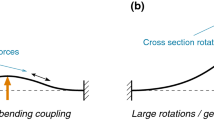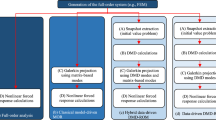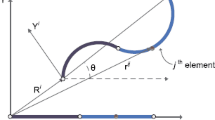Abstract
Reduced order models for the dynamics of geometrically exact planar rods are derived by projecting the nonlinear equations of motion onto a subspace spanned by a set of proper orthogonal modes. These optimal modes are identified by a proper orthogonal decomposition processing of high-resolution finite element dynamics. A three-degree-of-freedom reduced system is derived to study distinct categories of motions dominated by a single POD mode. The modal analysis of the reduced system characterizes in a unique fashion for these motions, since its linear natural frequencies are near to the natural frequencies of the full-order system. For free motions characterized by a single POD mode, the eigen-vector matrix of the derived reduced system coincides with the principal POD-directions. This property reflects the existence of a normal mode of vibration, which appears to be close to a slow invariant manifold. Its shape is captured by that of the dominant POD mode. The modal analysis of the POD-based reduced order system provides a potentially valuable tool to characterize the spatio-temporal complexity of the dynamics in order to elucidate connections between proper orthogonal modes and nonlinear normal modes of vibration.
Similar content being viewed by others
References
Rosenberg, R. M., ‘Normal modes of non-linear dual mode systems’, Journal of Applied Mechanics 1960, 263–268.
Rosenberg, R. M., ‘On the existence of normal modes of vibration of a nonlinear system with two degrees of freedom’, Quarterly of Applied Mathematics 22(3), 1964, 217–234.
Rand, R. H., ‘A direct method for non-linear normal modes’, International Journal of Non-Linear Mechanics 9, 1974, 363–368.
Nayfeh, A. H. and Nayfeh, S. A., ‘On non-linear modes of continuous systems’, Journal of Vibration and Acoustics 116, 1994, 129–136.
Vakakis, A. F. and Rand, R. H., ‘Normal modes and global dynamics of a two-degree-of-freedom nonlinear system. I. Low energies’, International Journal of Non-Linear Mechanics 27(5), 1992, 861–873.
Kelly, A., ‘On the Lyapunov center manifold’, Journal of Mathematical Analysis and Applications 18, 1967, 472–478.
Shaw, S. W. and Pierre, C., ‘Normal modes for nonlinear vibratory systems’, Journal of Sound and Vibration 164, 1993, 85–124.
Mazzilli, C. E. N., Soares, M. E. S., and Baracho, N., ‘Reduction of finite-element models of planar frames using non-linear normal modes’, International Journal of Solids and Structures 38, 2001, 1993–2008.
Bathe, K.-J., Finite Element Procedures in Engineering Analysis, Prentice-Hall, New Jersey, 1982.
Chung, T. J., Applied Continuum Mechanics, Cambridge University Press, New York, 1996.
Sirovich, L., ‘Turbulence and dynamics of coherent structures’, Quarterly of Applied Mathematics 45, 1987, 561–571.
Georgiou, I. T. and Sansour, E., ‘Analysing the finite element dynamics of nonlinear in-plane rods by the method of proper orthogonal decomposition’, in Computational Mechanics, New Trends and Applications, S. Idelsohn, E. Onate, and E. Dvorkin (eds.), CIMNE, Barcelona, Spain, 1998.
Rubin, M. B., Cosserat Theories: Shells, Rods and Points, Kluwer Academic Publishers, Dordrecht, The Netherlands, 2000.
Sansour, C. and Bednarczyk, H., ‘The Cosserat surface as a shell model, theory and finite element formulation’, Computer Methods in Applied Mechanics and Engineering 120, 1995, 1–32.
Georgiou, I. T., ‘On proper orthogonal decompositions for one-dimensional coupled structural dynamics: Characterization of coupled vibrations in nonlinear elastic rods’, 2004 (unpublished).
Feeny, B. F. and Kappagantu, R., ‘On the physical interpretation of proper orthogonal modes in vibrations’, Journal of Sound and Vibration 211(4), 1998, 607–616.
Georgiou, I. T. and Schwartz, I. B., 1999, ‘Dynamics of large scale coupled structural/mechanical systems: A singular perturbation/Proper Orthogonal Decomposition approach’, SIAM Journal of Applied Mathematics 59(4), 1999, 1178– 1207.
Aubry, N, Holmes, P, Lumley, J. L., and Stone E., ‘The dynamics of coherent structures in the wall region of a turbulent boundary layer’, Journal of Fluid Mechanics 192, 1988, 115–173.
Steindl, A. and Troger, H., ‘Methods for dimension reduction and their application in nonlinear dynamics’, International Journal of Solids and Structures 38, 2001, 2131–2147.
Rega, G. and Alaggio, R., ‘Spatio-temporal dimensionality in the overall complex dynamics of an experimental cable/mass system’, International Journal of Solids and Structures 38, 2001, 2049–2068.
Chidamparan, P. and Leissa, A. W., ‘Vibrations of planar curved beams, rings, and arches’, Applied Mechanics Review 46(9), 1993, 467–482.
Georgiou, I. T. and Kanavis, C., ‘A POD-Based identification of the reduced dynamics of an exact rod loaded transversely’, in Proceedings of DETC’03, ASME 2003 Design Engineering Technical Conferences and Computers and Information in Engineering Conference, Chicago, IL, September 2–6, 2003.
Temam, R., Infinite-Dimensional Dynamical Systems in Mechanics and Physics, Springer-Verlag, New York, 1988.
Georgiou, I. T., ‘Identification and construction of reduced order models for infinite-dimensional systems in nonlinear elastodynamics’, in Proceedings of IUTAM Symposium on Chaotic Dynamics and Control of Systems and Processes in Mechanics, Rome, Italy, June 8–13, 2004.
Georgiou, I. T., Schwartz, I. B., Emaci, E., and Vakakis, A., ‘Interaction between slow and fast oscillations in an infinite degree-of-freedom linear system coupled to a nonlinear subsystem: Theory and experiment’, Journal of Applied Mechanics 66, 1999, 448–459.
Georgiou, I. T. and Schwartz, I. B., ‘Slaving the in-plane motions of a nonlinear plate to its flectural motions: An invariant manifold approach’, Journal of Applied Mechanics 64, 1997, 175–181.
Taylor, A. E. and Lay, D. C., Introduction to Functional Analysis, 2nd edn., Krieger, Malabar, FL, 1986.
Bowen, R. M. and Wang, C.-C., Introduction to Vectors and Tensors: Linear and Multilinear Algebra, Plenum Press, New York, 1980.
Jones, C., ‘Geometric singular perturbations in dynamical systems’, Springer Lecture Notes Mathematics 1609, 1995, 44–120.
Georgiou, I. T., Corless, M. J., and Bajaj, A. K., ‘Dynamics of nonlinear structures with multiple equilibria: A singular perturbation-invariant manifold approach’, Zeitschrift für angewandte Mathematik und Physik 50, 1999, 892–924.
Author information
Authors and Affiliations
Corresponding author
Rights and permissions
About this article
Cite this article
Georgiou, I. Advanced Proper Orthogonal Decomposition Tools: Using Reduced Order Models to Identify Normal Modes of Vibration and Slow Invariant Manifolds in the Dynamics of Planar Nonlinear Rods. Nonlinear Dyn 41, 69–110 (2005). https://doi.org/10.1007/s11071-005-2793-0
Received:
Accepted:
Issue Date:
DOI: https://doi.org/10.1007/s11071-005-2793-0




